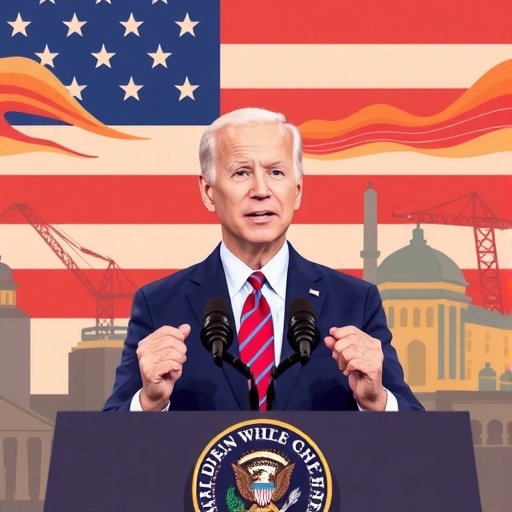Biden Administration Unveils Ambitious Economic Initiatives to Tackle Inflation and Supercharge Infrastructure
In a sweeping effort to reignite American economic momentum, the Biden Administration today announced a series of bold economic initiatives designed to combat persistent inflation while pouring billions into crumbling infrastructure. The centerpiece of the plan is a $750 billion investment in roads, bridges, and broadband networks over the next five years, coupled with tax reforms aimed at ensuring corporations pay their fair share. This announcement, delivered from the White House Rose Garden, comes at a critical juncture as inflation hovers around 3.2% and supply chain bottlenecks continue to strain the economy.
- $750 Billion Infrastructure Overhaul Targets Aging Bridges and Rural Broadband Gaps
- Tax Reforms Aim to Close Corporate Loopholes and Ease Middle-Class Burdens
- Inflation Fighters: How These Initiatives Promise to Stabilize Prices and Spur Growth
- Job Creation Boom: Millions of Opportunities from Coast to Coast
- Political Battles and Global Ripples: What Lies Ahead for These Economic Reforms
President Joe Biden, flanked by Treasury Secretary Janet Yellen and Transportation Secretary Pete Buttigieg, emphasized the urgency of these measures. “We’re not just fixing roads; we’re building a future where every American has access to opportunity,” Biden declared, highlighting how these economic initiatives will create over 2 million jobs and stimulate long-term growth. The proposals build on the successes of the 2021 Infrastructure Investment and Jobs Act but address gaps exposed by recent economic turbulence.
$750 Billion Infrastructure Overhaul Targets Aging Bridges and Rural Broadband Gaps
The Biden Administration‘s economic initiatives place a heavy emphasis on infrastructure, with a proposed $750 billion allocation that dwarfs previous federal spending in this arena. This funding will prioritize the repair and modernization of the nation’s 45,000 structurally deficient bridges, many of which date back to the mid-20th century and pose safety risks to millions of daily commuters. According to the American Society of Civil Engineers (ASCE), the U.S. infrastructure earns a dismal C- grade, and without intervention, maintenance costs could balloon to $2.6 trillion by 2029.
Key components of the infrastructure push include $300 billion for highway and bridge repairs, $150 billion for expanding high-speed rail networks in underserved regions, and $200 billion dedicated to broadband expansion. Rural areas, which have lagged in digital connectivity, stand to benefit immensely; the plan aims to connect 95% of American households to reliable internet by 2030, up from the current 80%. “Broadband isn’t a luxury—it’s essential for education, healthcare, and business,” Yellen stated during the briefing, underscoring how these investments align with the Administration’s broader economic initiatives to bridge the urban-rural divide.
Statistics underscore the need: A 2023 Federal Highway Administration report revealed that traffic congestion alone costs the U.S. economy $160 billion annually in lost productivity. By injecting funds into smart traffic systems and electric vehicle charging stations, the Biden Administration expects to reduce these losses by 25% within a decade. Environmental advocates praise the green focus, with $100 billion earmarked for sustainable projects like solar-powered public transit, potentially cutting transportation emissions by 40% in participating cities.
Local leaders are already gearing up. In Pennsylvania, Governor Josh Shapiro announced plans to use federal matching funds for the reconstruction of the I-95 corridor, a project stalled for years due to funding shortages. “This is a game-changer for our state’s economy,” Shapiro said in a statement, predicting 50,000 new construction jobs in the Keystone State alone.
Tax Reforms Aim to Close Corporate Loopholes and Ease Middle-Class Burdens
Complementing the infrastructure boom, the Biden Administration’s economic initiatives introduce comprehensive tax reforms projected to generate $2.5 trillion in revenue over the next decade. At the heart of these changes is a proposal to raise the corporate tax rate from 21% to 28%, targeting multinational corporations that have exploited offshore tax havens to minimize liabilities. The plan also eliminates carried interest loopholes, which allow hedge fund managers to classify income as capital gains and pay lower rates.
“It’s time the wealthiest pay their fair share so we can invest in the backbone of our economy,” Biden remarked, referencing data from the Institute on Taxation and Economic Policy showing that 55 of the largest U.S. corporations paid zero federal taxes in 2020 despite billions in profits. These reforms are expected to offset the costs of infrastructure spending without raising taxes on households earning under $400,000 annually—a promise Biden has reiterated since his 2020 campaign.
Additional measures include expanding the Child Tax Credit to $3,600 per child, which economists estimate could lift 3 million children out of poverty and boost consumer spending by $100 billion yearly. For small businesses, the plan offers a 20% deduction on new infrastructure-related investments, incentivizing participation in the broader economic initiatives. The Tax Policy Center projects that these changes will reduce the federal deficit by $1.2 trillion while maintaining progressivity.
Critics from the business sector, including the U.S. Chamber of Commerce, warn of potential job losses if corporate taxes rise too steeply. However, Yellen countered, citing OECD studies that show countries with higher corporate rates, like France at 25%, still attract investment through stable economic policies. The reforms also include incentives for domestic manufacturing, such as tax credits for companies reshoring supply chains disrupted by the pandemic.
Inflation Fighters: How These Initiatives Promise to Stabilize Prices and Spur Growth
With inflation remaining a top concern for voters—polls show 60% of Americans citing it as their primary economic worry—the Biden Administration’s economic initiatives are crafted to address root causes. By investing heavily in infrastructure, the plan aims to alleviate supply chain pressures that have driven up costs for goods like lumber and steel. For instance, modernizing ports and rail lines could reduce shipping delays by 30%, according to a McKinsey Global Institute analysis, directly lowering import prices.
The Federal Reserve’s recent rate hikes have cooled inflation from a peak of 9.1% in 2022, but experts agree sustained growth requires fiscal support. The infrastructure component is projected to add 1.5% to GDP annually through 2028, per the Congressional Budget Office (CBO), by creating multiplier effects in related industries like manufacturing and logistics. Tax reforms, meanwhile, will fund social safety nets that prevent inflationary wage-price spirals; expanded credits could increase disposable income for low-wage workers without overheating the labor market.
Real-world examples abound. In the wake of Hurricane Ida in 2021, resilient infrastructure investments in Louisiana saved an estimated $5 billion in recovery costs. The Biden Administration draws parallels, positioning these economic initiatives as proactive defenses against future shocks, including climate-driven disruptions. Economists like Mark Zandi of Moody’s Analytics applaud the balanced approach: “This isn’t just spending—it’s strategic investment that could keep inflation below 2% long-term.”
Yet, challenges persist. Supply-side bottlenecks, exacerbated by global events like the Ukraine conflict, mean implementation must be swift. The Administration plans to fast-track permits for priority projects, cutting approval times from years to months via executive orders.
Job Creation Boom: Millions of Opportunities from Coast to Coast
One of the most compelling aspects of the Biden Administration’s economic initiatives is the projected job surge. The infrastructure investments alone are forecasted to generate 2.2 million positions, with 40% targeted at unions and underrepresented communities. Construction roles will dominate initially, but the ripple effects extend to engineering, tech, and green energy sectors. The Department of Labor estimates an additional 500,000 jobs in broadband installation, many in rural Midwest and Southern states hit hard by automation.
Women and minorities stand to gain disproportionately; the plan mandates 30% of contracts go to diverse-owned firms, building on the Administration’s equity agenda. In Detroit, for example, a $10 billion allocation for EV battery plants could revive the auto industry’s heartland, creating 20,000 high-wage jobs. “These aren’t temporary gigs—they’re pathways to the middle class,” Buttigieg emphasized, pointing to apprenticeship programs that will train 1 million workers in emerging technologies.
Broader economic growth is anticipated too. The IMF predicts that similar infrastructure pushes in Europe have yielded 1.8% annual GDP boosts; the U.S. could see comparable gains, potentially lifting median household income by $2,500 by 2030. Small business owners, via tax incentives, will hire more as demand rises—think local suppliers for bridge projects or software firms for smart grid systems.
Success stories from the Bipartisan Infrastructure Law, like the $1.2 billion Brent Spence Bridge replacement in Ohio and Kentucky, illustrate the potential. That project alone created 1,500 jobs and is expected to handle 25% more freight, easing inflation in goods transport.
Political Battles and Global Ripples: What Lies Ahead for These Economic Reforms
As the Biden Administration pushes forward with these economic initiatives, political headwinds loom large. With midterm elections approaching, Republicans in Congress have signaled opposition, labeling the tax hikes as “job-killing socialism.” Senate Minority Leader Mitch McConnell called for bipartisan tweaks, warning that without them, the package could stall in reconciliation. Yet, polls from Gallup indicate 65% public support for infrastructure spending, giving Democrats leverage.
Implementation timelines are ambitious: The Administration aims for $200 billion in obligated funds by fiscal year 2024, with states required to submit proposals within 90 days. Oversight will come via a new Infrastructure Accountability Board, ensuring transparency and efficiency. Internationally, these moves position the U.S. competitively; as China invests $1.3 trillion in its Belt and Road Initiative, Biden’s plan counters with domestic resilience, potentially attracting foreign direct investment in green tech.
Looking ahead, success hinges on execution. If realized, these economic initiatives could usher in a new era of prosperity, reducing inequality and fortifying America against recessions. Economists forecast a soft landing for the economy, with unemployment dipping below 3.5% and inflation stabilizing at the Fed’s 2% target by 2026. For everyday Americans—from truck drivers on repaired highways to families with faster internet—these changes promise tangible relief and opportunity in an uncertain world.








